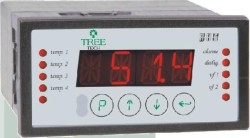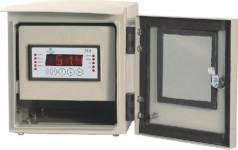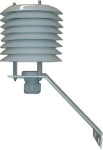DTM -Temperature Monitor for Dry Transformers, Motors and Generators
The DTM Temperature Monitor has three temperature reading inputs (optional fourth input), allowing monitoring of multiple temperatures. A few typical applications for the DTM are, among others:
• Temperatures of phases A, B and C of dry transformers, with the fourth optional input being used to monitor core temperature or ambient temperature;
• Small scale transformer oil temperatures, where measuring the temperature of the winding is not needed (for winding temperature, see catalog TM1/TM2);
• Temperatures of stator, bearing seats, lubricant oil, etc. in motors and generators. For each temperature monitored, alarm and equipment shut down values are adjusted individually in order to avoid permanent damage, in addition to the optional adjustments forautomatic activation of forced cooling systems in two stages (for example, fans).
Main Features:
• IED (Intelligent Electronic Device) designed specifically for substation yard conditions (interference, extreme temperatures);
• Real time temperature reading on display, with programmable display mode: indication of highest temperature, automatic screen roll and fixed channel reading indication;
• High-glow LED type display for easy visualization; and operation in extreme ambient light;
• Serial communication port RS485 (optional) for integration into supervision or remote monitoring systems. Open communication protocols Modbus RTU or DNP3.0;
• Input for self-calibrating Pt100W at 0ºC RTD type temperature sensors, ensuring high-level accuracy and stability throughout the entire ambient temperature range;
• Programmable analog output (optional) for remote temperature readings. Programmable output range: 0…1, 0…5, 0…10, 0…20 or 4…20mA;
• Output relays for alarm indications, trip, self-diagnostic and command of two-stage forced cooling (optional);
• Internal clock with date and time and non-volatile memory for storage of readings (optional);
• Self-diagnostic for internal fault detection. Total absence of mechanical parts for parameter setting and calibration.
• Additional Temperature Reading
Additional input for measuring of fourth temperature (for sensor Pt100W at 0ºC), allowing measuring of the temperature of the core, ambient temperature or other;
• Analog Output
Programmable analog output for remote temperature reading indication, user selectable for display of highest temperature or a pre-defined temperature. Programmable output range: 0…1, 0…5, 0…10, 0…20 or 4…20mA;
• Activation of Forced Cooling
Two NC (normally closed) output relays for control of two-stage forced cooling. Programmable activation mode in Manual or Automatic, with adjustable activation and hysteresis temperatures. Forced activation of cooling in case of lack of auxiliary supply, internal fault or fault in temperature sensor;
• Serial Communication Port RS485
Serial communication port RS485 for integration into remote supervision systems, allowing the establishment of a temperature monitoring network covering the entire facility. User selectable communication protocol in Modbus RTU or DNP3.0 level 1;
• Mass Memory
Non-volatile memory for storage of temperature readings and alarm events, transformer trip and activation of forced cooling, based on internal clock with day, month, year, hour, minute and second. A memory recording can be started by:
– User defined time interval between recordings, or;
– Variation of any temperature monitored higher than the dead band selected by users, in ºC, or;
– State change in any output relay (control of cooling, alarms, trips or self-diagnostic).



